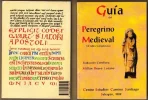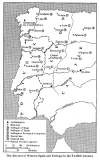A good story does not have to be true to be nice!
sillydoll said:
We both were on national radio in an interview on pilgrimage where Jan said: "Anybody may call himself a pilgrim." A quote I often and thankfully use. Stories, stories and more stories... we musn't forget that most historians agree that Jacobus never visited Spain. I remember a story from a council at Montserrat near Barcelona where Gelmírez proposed to beatify Saint James (or make him archbishop or whatever) and his colleagues simply said: Why, he's never been here!"
Is that story true? I wouldn't know; I wasn't there and don't care; I only vaguely remember and like it because it
could have been true in those days of battles for power. Life was hard and Gelmírez had a goal and not much time so he wanted to score quickly! See the amazing map of Bishoprics that were suffragan (subordinate) of the Archbishopric of Santiago de Compostela like Ávila and Salamanca and closer places like Mondoñedo, Lugo, Orense, Tuy and Porto that were suffragan of Braga. Oviedo, León and Burgos were exempt sees whatever that may mean.
-
Saint James's Catapult, The Life and Times of Diego Gelmírez of Santiago de Compostela,
R.A. Fletcher, 1984 and read the full-text-on-line on
http://libro.uca.edu/sjc/sjc.htm
-
http://www.archive.org/details/historyo ... 00fletuoft - A history of architecture on the comparative method (1905), Author: Fletcher, Banister, 1833-1899 > p424: "Santiago was a pilgrimage centre of more than national importance." flip book (2000 pictures!)
-
http://en.wikipedia.org/wiki/Banister_Fletcher - Sir Banister Flight Fletcher (1866-1953) was an English architect and architectural historian, as was his father, also named Banister Fletcher. With his father, he co-authored the first edition of A History of Architecture (A History of Architecture on the Comparative Method - Authors: Fletcher, Banister, 1833-1899 & Fletcher, Banister, Sir, 1866-1953). London: Athlone Press, University of London, 1896 [issued serially], first single-volume edition, London: B.T. Batsford and New York: C. Scribner's Sons, 1897, now in its twentieth edition (ISBN 0-7506-2267-9)
-
http://en.wikipedia.org/wiki/Diego_Gelm%C3%ADrez
- Sources, books & reviews on 'King' and others on
pilgrim-books/topic3632.html#p19440


















